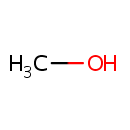
Methanol (PAMDB000425)
| Record Information | |||||||||||||||||||||||||||||||||||||||||||||||||||||||||||||||||||||
|---|---|---|---|---|---|---|---|---|---|---|---|---|---|---|---|---|---|---|---|---|---|---|---|---|---|---|---|---|---|---|---|---|---|---|---|---|---|---|---|---|---|---|---|---|---|---|---|---|---|---|---|---|---|---|---|---|---|---|---|---|---|---|---|---|---|---|---|---|---|
| Version | 1.0 | ||||||||||||||||||||||||||||||||||||||||||||||||||||||||||||||||||||
| Update Date | 1/22/2018 11:54:54 AM | ||||||||||||||||||||||||||||||||||||||||||||||||||||||||||||||||||||
| Metabolite ID | PAMDB000425 | ||||||||||||||||||||||||||||||||||||||||||||||||||||||||||||||||||||
| Identification | |||||||||||||||||||||||||||||||||||||||||||||||||||||||||||||||||||||
| Name: | Methanol | ||||||||||||||||||||||||||||||||||||||||||||||||||||||||||||||||||||
| Description: | Methanol is the simplest alcohol, and is a light, volatile, colourless, flammable, poisonous liquid with a distinctive odor that is somewhat milder and sweeter than ethanol. It is produced naturally in the anaerobic metabolism of many varieties of bacteria, and is ubiquitous in the environment. As a result, there is a small fraction of methanol vapor in the atmosphere. (Wikipedia). | ||||||||||||||||||||||||||||||||||||||||||||||||||||||||||||||||||||
| Structure | |||||||||||||||||||||||||||||||||||||||||||||||||||||||||||||||||||||
| Synonyms: |
| ||||||||||||||||||||||||||||||||||||||||||||||||||||||||||||||||||||
| Chemical Formula: | CH4O | ||||||||||||||||||||||||||||||||||||||||||||||||||||||||||||||||||||
| Average Molecular Weight: | 32.0419 | ||||||||||||||||||||||||||||||||||||||||||||||||||||||||||||||||||||
| Monoisotopic Molecular Weight: | 32.02621475 | ||||||||||||||||||||||||||||||||||||||||||||||||||||||||||||||||||||
| InChI Key: | OKKJLVBELUTLKV-UHFFFAOYSA-N | ||||||||||||||||||||||||||||||||||||||||||||||||||||||||||||||||||||
| InChI: | InChI=1S/CH4O/c1-2/h2H,1H3 | ||||||||||||||||||||||||||||||||||||||||||||||||||||||||||||||||||||
| CAS number: | 67-56-1 | ||||||||||||||||||||||||||||||||||||||||||||||||||||||||||||||||||||
| IUPAC Name: | methanol | ||||||||||||||||||||||||||||||||||||||||||||||||||||||||||||||||||||
| Traditional IUPAC Name: | methanol | ||||||||||||||||||||||||||||||||||||||||||||||||||||||||||||||||||||
| SMILES: | CO | ||||||||||||||||||||||||||||||||||||||||||||||||||||||||||||||||||||
| Chemical Taxonomy | |||||||||||||||||||||||||||||||||||||||||||||||||||||||||||||||||||||
| Taxonomy Description | This compound belongs to the class of organic compounds known as primary alcohols. These are compounds comprising the primary alcohol functional group, with the general structure RCOH (R=alkyl, aryl). | ||||||||||||||||||||||||||||||||||||||||||||||||||||||||||||||||||||
| Kingdom | Organic compounds | ||||||||||||||||||||||||||||||||||||||||||||||||||||||||||||||||||||
| Super Class | Organooxygen compounds | ||||||||||||||||||||||||||||||||||||||||||||||||||||||||||||||||||||
| Class | Alcohols and polyols | ||||||||||||||||||||||||||||||||||||||||||||||||||||||||||||||||||||
| Sub Class | Primary alcohols | ||||||||||||||||||||||||||||||||||||||||||||||||||||||||||||||||||||
| Direct Parent | Primary alcohols | ||||||||||||||||||||||||||||||||||||||||||||||||||||||||||||||||||||
| Alternative Parents | |||||||||||||||||||||||||||||||||||||||||||||||||||||||||||||||||||||
| Substituents |
| ||||||||||||||||||||||||||||||||||||||||||||||||||||||||||||||||||||
| Molecular Framework | Aliphatic acyclic compounds | ||||||||||||||||||||||||||||||||||||||||||||||||||||||||||||||||||||
| External Descriptors |
| ||||||||||||||||||||||||||||||||||||||||||||||||||||||||||||||||||||
| Physical Properties | |||||||||||||||||||||||||||||||||||||||||||||||||||||||||||||||||||||
| State: | Liquid | ||||||||||||||||||||||||||||||||||||||||||||||||||||||||||||||||||||
| Charge: | 0 | ||||||||||||||||||||||||||||||||||||||||||||||||||||||||||||||||||||
| Melting point: | -97.6 °C | ||||||||||||||||||||||||||||||||||||||||||||||||||||||||||||||||||||
| Experimental Properties: |
| ||||||||||||||||||||||||||||||||||||||||||||||||||||||||||||||||||||
| Predicted Properties |
| ||||||||||||||||||||||||||||||||||||||||||||||||||||||||||||||||||||
| Biological Properties | |||||||||||||||||||||||||||||||||||||||||||||||||||||||||||||||||||||
| Cellular Locations: | Cytoplasm | ||||||||||||||||||||||||||||||||||||||||||||||||||||||||||||||||||||
| Reactions: | Water + Pimeloyl-[acyl-carrier protein] methyl ester > Methanol + Pimeloyl-[acyl-carrier protein] Methanol + Hydrogen peroxide <> Formaldehyde +2 Water L-Lyxose + Water <> Methanol + Pectic acid Ecgonine methyl ester + Water <> Ecgonine + Methanol Pimelyl-[acyl-carrier protein] methyl ester + Water + Pimeloyl-[acyl-carrier protein] methyl ester <> Pimelyl-[acyl-carrier protein] + Methanol + Pimeloyl-[acyl-carrier protein] Pimelyl-[acyl-carrier protein] methyl ester + Water > pimelyl-[acyl-carrier protein] + Methanol Protein L-glutamate O(5)-methyl ester + Water > protein L-glutamate + Methanol Pectin + Water <> Methanol + Pectic acid Protein glutamate methyl ester + Water <> Protein glutamate + Methanol a pimeloyl-[acp] methyl ester + Water > Methanol + a pimeloyl-[acp] | ||||||||||||||||||||||||||||||||||||||||||||||||||||||||||||||||||||
| Pathways: |
| ||||||||||||||||||||||||||||||||||||||||||||||||||||||||||||||||||||
| Spectra | |||||||||||||||||||||||||||||||||||||||||||||||||||||||||||||||||||||
| Spectra: |
| ||||||||||||||||||||||||||||||||||||||||||||||||||||||||||||||||||||
| References | |||||||||||||||||||||||||||||||||||||||||||||||||||||||||||||||||||||
| References: |
| ||||||||||||||||||||||||||||||||||||||||||||||||||||||||||||||||||||
| Synthesis Reference: | Cummings, Donald Ray. Process for production of methanol from a methane gas stream. PCT Int. Appl. (2007), 21pp. | ||||||||||||||||||||||||||||||||||||||||||||||||||||||||||||||||||||
| Material Safety Data Sheet (MSDS) | Download (PDF) | ||||||||||||||||||||||||||||||||||||||||||||||||||||||||||||||||||||
| Links | |||||||||||||||||||||||||||||||||||||||||||||||||||||||||||||||||||||
| External Links: |
| ||||||||||||||||||||||||||||||||||||||||||||||||||||||||||||||||||||
Enzymes
- General function:
- Involved in two-component response regulator activity
- Specific function:
- Involved in the modulation of the chemotaxis system; catalyzes the demethylation of specific methylglutamate residues introduced into the chemoreceptors (methyl-accepting chemotaxis proteins) by CheR
- Gene Name:
- cheB
- Locus Tag:
- PA0173
- Molecular weight:
- 37.3 kDa
Reactions
| Protein L-glutamate O(5)-methyl ester + H(2)O = protein L-glutamate + methanol. |
- General function:
- Involved in catalase activity
- Specific function:
- Decomposes hydrogen peroxide into water and oxygen; serves to protect cells from the toxic effects of hydrogen peroxide
- Gene Name:
- katE
- Locus Tag:
- PA2147
- Molecular weight:
- 78 kDa
Reactions
| 2 H(2)O(2) = O(2) + 2 H(2)O. |

